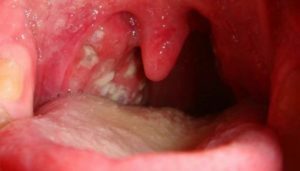 Herpetic gingivostomatitis is a disease of the oral mucosa provoked by the Herpes simplex virus. Acute herpetic gingivostomatitis( OCG) is most common in children, but can also occur in adults.
Herpetic gingivostomatitis is a disease of the oral mucosa provoked by the Herpes simplex virus. Acute herpetic gingivostomatitis( OCG) is most common in children, but can also occur in adults.
Stomatitis of any origin causes severe discomfort to the patient.
The disease is caused by viruses belonging to the herpesvirus family. They include the following 8 types:
- HSV-1 and HSV-2;
- varicella-zoster virus;
- Epstein-Barr virus;
- CMV;
- herpes virus 6, 7, 8th type.
Infected with infection is possible absolutely from any virus carrier. From relatives, friends, co-workers and even sick with a virus of domestic animals, when saliva hits the skin and mucous membranes of a healthy person. The source of the infection is primarily a patient. The causative agent may not stand out for a long time. Therefore, it is almost impossible to recognize the carrier. Only the pronounced symptoms of herpes, which are in the open areas of the body of the patient, will allow to know about the presence of the virus.
Contents
-
-
- Acute herpetic gingivitis in children
- Disease in mild form
- Severe and severe
- Heavy form( aphoidPospisilla)
- Methods of treatment of different forms of the disease
- Treatment with mild
- Treatment at moderate severity of illness
- Treatment of severe
- What are the possible consequences and complications?
- Conclusion
How can you get infected with the
virus? An increased risk of infection is the direct entry of the virus into the oral cavity when kissing or when an infected toothbrush is used. The ability of the Herpes virus to be transmitted to others is very high. You can get infected in places of frequent congestion of the people. With a cold snap the risk of infection increases. The virus is very contagious and is transmitted in the following ways:
- by a contact route with infected people;
- due to sexual contact, with damage to the skin;
- by airborne droplets, by inhalation or through household items;
- by hematogenous method( through blood);
- as a result of the application of toothpastes containing sodium lauryl sulfate.
The first symptoms of the disease
From the 1st to the 8th day of the presence of the virus in the blood, it is difficult to recognize the disease due to the manifestation of common symptoms: weakness, lethargy, headaches, drowsiness. Later, other symptoms are most likely to indicate acute gingivostomatitis, such as:
- pain when swallowing;
- sharp rise in temperature to 40 degrees;
- vomiting and seizures;
- edema of the oral mucosa;
- plaque white in tongue and cheeks;
- poor sleep, lethargy, decreased appetite;
- enlarged lymph nodes.
The main indicator of the disease is the defeat of the surface of the tongue with erosions along the gingival margin and on the mucous membrane of the mouth. After the first day, this manifestation can be distinguished by the following listed symptoms of the extensive process:
- of the rash of the mouth, cheeks and palate;
- plaque on the tonsils;
- painful ulcers;
- bubbles with liquid;
- is a viscous saliva.
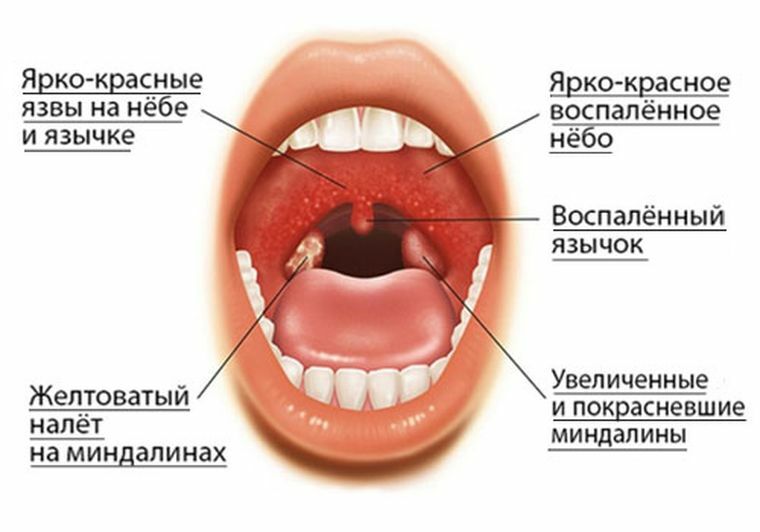
Manifestations of the disease last for 5-10 days. During this period, it is possible to damage the face, sometimes the hands. Other mucous membranes located, for example, in the digestive tract, can be affected. Painful sensations arise in the course of the intestine. Later, there is involvement of throat, larynx, urethra, female genital organs, cornea of the eye.
Forms of severity of the disease
Depending on the severity of toxicosis and the area of the oral surface, the disease is divided into the following forms:
- incubation period;
- easy;
- average;
- is heavy.
Incubation period
The incubation stage lasts about a week. The disease develops rapidly, more often with a temperature reaching 39 degrees, and severe malaise. After two days there is discomfort in the mouth, growing at the time of eating and talking. On the edematous mucous there are eruptions, single or in quantity from 2 to several tens. To note them is not difficult, as they rapidly turn into sores that appear in the language, the sky and the face. Damaged gum on the inside, covered with a purulent coating. Salivation is viscous, increasing with time. This process lasts another 5-10 days after the inflammation of ulcers.
The mild form of the disease
It is difficult to detect an easy stage of the pathological process due to mild symptoms of the flow.
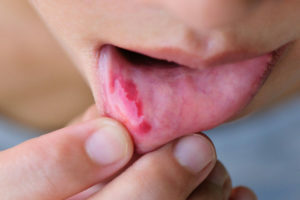
Rashes or not, or there are 1-2 flat-shaped ulcers, manifesting as a painless little spot in the inner surface of the mouth.
After a few hours, the inflammatory process intensifies, and the sores become painful and fill with fluid inside. At the same time, there is an increase in lymph nodes. After 2-3 days, the healing phase of ulcer-erosions begins. Relapses of this form of the disease depend entirely on the human immune system.
The average form of severity
It is characterized by prolonged healing of ulcers up to 2-3 weeks, and especially deep erosions disappear in a month or more. With this form, patients still suffer regular relapses with a frequency of a month. Ulceration-erosion goes deep into the mucous membrane, causing severe painful sensations on contact. Exacerbations of the middle form come at once - the ulcers become denser, eroding the mucous surface of erosion, and then deepen. Later, healing of ulcers occurs with the formation of scars.
Disease of severe form
Severe course of the disease occurs less frequently than others, but is characterized by the sudden formation of several ulcers on the oral mucosa. Such manifestations are affected by patients suffering from allergies, gastrointestinal diseases, rheumatism, and those who have undergone viral infections. The primary symptoms are:
- flaccid state;
- high temperature;
- headache;
- joint pain;
- pain in the oral cavity;
- poor appetite;
- apathy and depression;
- sleep disturbance.
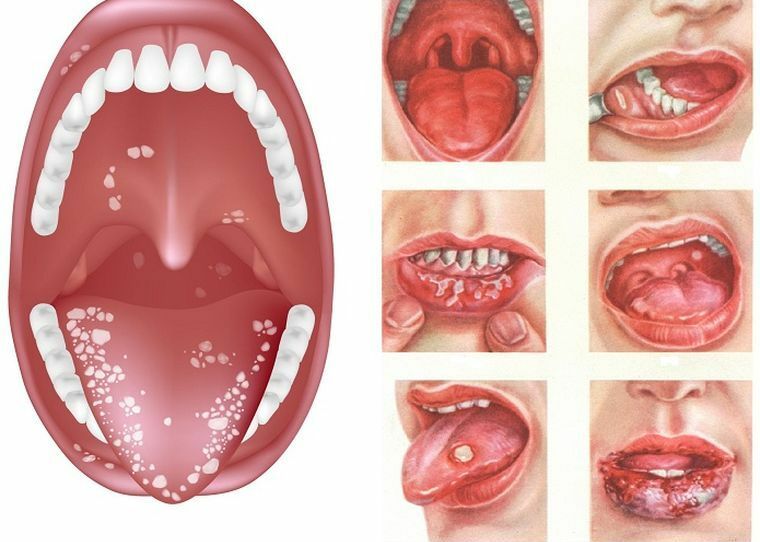
A blood test diagnoses white blood cell growth and an increase in erythrocyte sedimentation rate, which clearly indicates a pronounced inflammatory process. On examination, new lesions of ulcers of different sizes are noticeable.
Acute herpetic gingivostomatitis in children
Children's OCS is the most common and often occurring infectious disease in childhood and infantile years. It begins with the inflammatory process of the oral mucosa with the manifestation of rash-bubbles, an increase in temperature and a decrease in overall immunity.
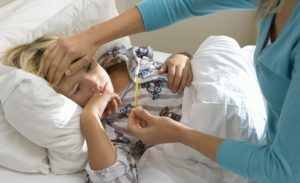 Most often, primary infection with a virus occurs after six months of a child's life. This is because before that, antibodies to the virus, acquired in utero, are present in the blood of the newborn, so infants are considered immune to maternal immunity.
Most often, primary infection with a virus occurs after six months of a child's life. This is because before that, antibodies to the virus, acquired in utero, are present in the blood of the newborn, so infants are considered immune to maternal immunity.
The frequency of cases of infection in children is as follows:
- from 1 to 5 years - 62-65%;
- from 5 to 7 years - 13-25%, after the incidence decreases;
- in adolescents 1-2%.
Multiple infection from six months to 3 years is due to the disappearance of antibodies acquired from the mother by the transplacental route, as well as the immaturity of the immune system. The disease rarely occurs in newborn babies of premature infants.
The disease manifests itself in the following forms:
- Acute herpetic gingivostomatitis is the primary herpetic infection caused by the virus for the first time.
- Chronic recurrent herpes.
- Generalized herpes - manifested in a baby born of a mother who did not have antibodies to the Herpes simplex virus. That is, the infant has not received passive maternal immunity. In the oral cavity, there are extensive necrosis. This form provokes the development of a complex septic disease with the defeat of internal organs and serous meninges. A fatal outcome is possible.
Symptoms of acute herpetic gingivostomatitis in children, depending on the degree of severity, are divided into the following forms:
Disease in mild form
The general condition of the child is violated slightly, the temperature is often within normal limits. The first symptom is the pain sensation when swallowed. During the examination, the mucosal edema can be traced and the formation of small erosions covered with a light coating. The disease lasts no more than five days.
Medium and severe
These forms of the disease are most common. The disease begins acutely with a body temperature of over 38 degrees, and in severe situations reaches 40 degrees. The child becomes sluggish, capricious. Appear complaints of pain, and sharply reduced appetite. There is a possibility of nausea and vomiting. Later, symptoms of ARI appear.
In this case, the pediatrician is needed, who, upon careful examination, will notice an increase in lymph nodes. In the period of 2-4 days of the disease, separate or grouped rashes appear in the mouth and face. First the bubbles are transparent, then cloudy. If ulcers are damaged, erosion of the skin is formed. Erosion ulcers are painful and cause severe discomfort, causing edema of the oral cavity and lining of the tongue. Saliva is viscous with an unpleasant odor.
Intoxication of the body. Most children develop deep ulcers. The disease, depending on the degree of severity, can last up to 15 days. Ulcers-erosions heal without scarring. The recurrence of the disease does not recur if a persistent immune system is observed.
Severe form( apophea Pospišil)
It is observed in children with weakened immunity, exhausted by viral infections. Ulceration-erosion affects not only the area of the mouth and skin of the face, but also the skin of the hands and genitals.
Methods of treatment of different forms of the disease
When first diagnosing symptoms of herpetic gingivitis or stomatitis, you should contact a qualified specialist: infectiologist and dentist. The doctor diagnoses the disease by conducting a survey and visual examination of the patient. Will evaluate the nature of the rashes and prescribe treatment. 
Therapy is reduced to the use of the following medicines:
- antipyretic and analgesic drugs;
- antiseptics;
- antiviral ointments and gels;
- decoction of medicinal herbs for the treatment of wounds.
At the time of extinction of the disease, it is recommended to observe the regularity of ulcer treatments with antiseptic solution, then with oil( vitamin A).Be sure to adhere to proper nutrition, feed the patient with food of soft consistency, give abundant drink. The ill person should be limited from visits to institutions and places of congestion due to the contagious disease. Those who care for the patient, it is necessary to observe basic hygiene rules.
Treatment in mild form of
To stop inflammation in the body, antiviral drugs are prescribed at the initial stage of the disease, namely:
- tablets Acyclovir, Zovirax, Bicyclovir, Acic, Gerpevir are prescribed in the first week of the disease for 1 pc.5 times a day for 5 days;
- preparations Interferon, Acyclovir, Acyclovad in the form of applications of solutions, creams or ointments for 20 min 5-7 times a day.
 Also in parallel with drug treatment can be applied methods of traditional medicine. An easy effect is provided by folk remedies in the form of decoctions and infusions of medicinal herbs( yarrow, sage, St. John's wort, camomile and calendula).
Also in parallel with drug treatment can be applied methods of traditional medicine. An easy effect is provided by folk remedies in the form of decoctions and infusions of medicinal herbs( yarrow, sage, St. John's wort, camomile and calendula).
Method of cooking the decoction from the above herbs - 1 tablespoon of dry herbs on a glass of boiling water. Pour and cover the container with a towel for 10 minutes, after decanting. Rinse the mouth before and after eating.
The following folk methods also help in the mild form of the disease:
- propolis infusion for relieving pain in the mouth;
- lemon juice with mucosal edema;
- flaxseed or sea buckthorn oil at the healing stage of ulcers.
Treatment for moderate to severe
There is general and local therapy to eliminate the average form of the disease. General therapy is aimed at preventing the spread of the virus and improving the overall immunity of the patient. Assign the following drugs:
- analgesics and antipyretic drugs: Paracetamol for children, Efferalgan, Nurofen, Tylenol;
- antiviral drugs: Acyclovir, Zovirax, Bicyclovir, Virollex, Herperax;
- antihistamines: Claritin, Tavegil, Suprastin, Fenkorol;
- vitamins: Ascorbic acid and Ascorutin;
- immunomodulators: IRS-19, Viferon, Anaferon, Arbidol, Imudon;
- abundant drink and adequate nutrition;
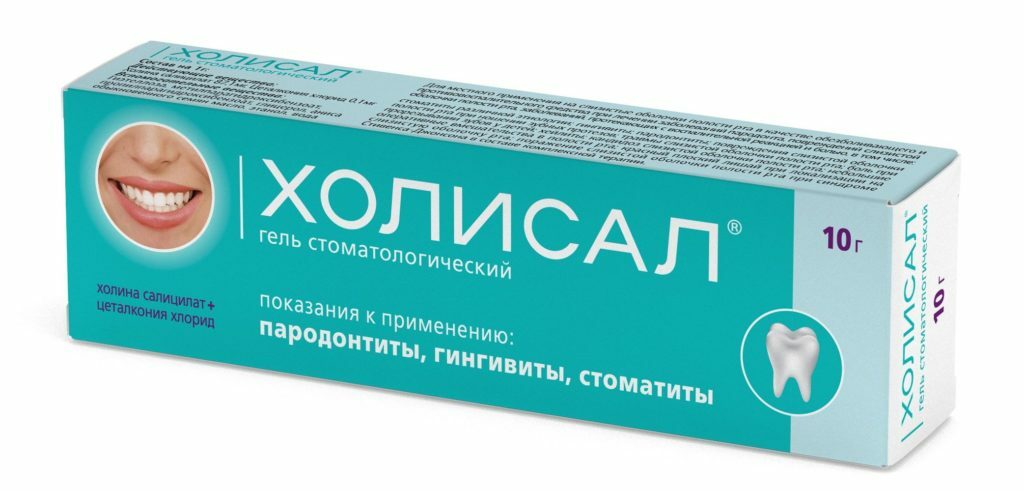
Local therapy aims to reduce pain and healing of erosive ulcers. Most often prescribed are topical preparations:
- antiseptics: weak solutions of Furacilin, Miramistin after each meal;
- antiviral and healing ointments and oils: Interferon, Acyclovir, Acyclovad, Sokloseril, Carotolin, Vitamin A oil solution, rose hips and sea-buckthorn oil;
- painkillers in the form of lotions and ointments: a solution of lidocaine and pyromecaine, holisal, mundizal gel;
- alcohol solution of brilliant green, Fukortzin( "red green"), hydrogen peroxide for the treatment of ulcers on the face and hands skin.
Treatment of severe disease
For severe disease, antibacterial drugs( broad-spectrum antibiotics) are prescribed as the main treatment method to prevent further development of the disease.
What can be the consequences and complications?
It is important to remember that gingivostomatitis is the most popular form of the disease, provoked by staphylococci, streptococci and diplococci. The most common disease is observed in children's general educational institutions. 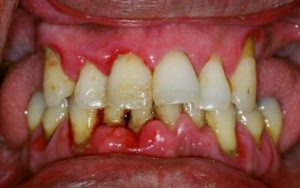 Inadequate and untimely treatment results in loss of teeth.
Inadequate and untimely treatment results in loss of teeth.
If not fully recovered, the disease can go into a chronic form. The danger of the disease is that the inflammation slowly affects the deep tissue layers, which increases the likelihood of developing periodontal disease, the manifestations of which can be seen in the photo on the left. In this case, partial damage or complete destruction of the ligamentous dental apparatus occurs.
Postponing treatment can lead to more serious viral infections that provoke the development of diphtheria, measles and influenza. Not adherence to the rules of hygiene and safety in case of illness can acquire the scale of the epidemic.
Conclusion
The cause of herpetic gingivostomatitis is always the Herpes virus. Its carrier is up to 90% of the population. Clinically, the infection manifests itself against the background of weakened immunity and the effect of the provoking factor. The frequency of recurrences of exacerbation is individual and depends on the level of human immune defense.
In adults, the disease is more severe than in children, especially if a person has not had stomatitis in childhood. The treatment procedure at different ages is different, so it is necessary to consult a specialist. The course of treatment should be comprehensive and respectful of diet and hygiene. In this case, getting rid of the disease will be much easier.
